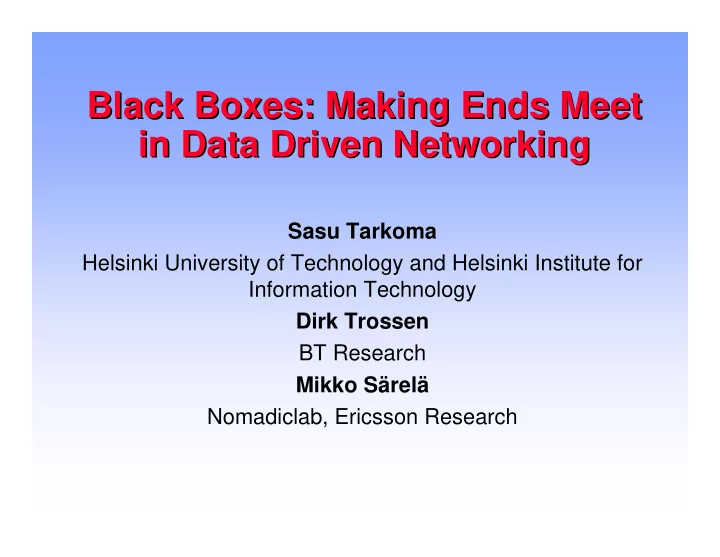

Black Boxes Boxes: : Making Making Ends Ends Meet Meet Black in Data Driven Driven Networking Networking in Data Sasu Tarkoma Helsinki University of Technology and Helsinki Institute for Information Technology Dirk Trossen BT Research Mikko Särelä Nomadiclab, Ericsson Research
Introduction Introduction • Current Internet is increasingly data and content centric • The protocol stack may not offer best support for this • End-to-end principle is no longer followed – Firewalls and NAT boxes – Peer-to-peer and intermediaries • Ultimately, hosts are interested in receiving valid and relevant information and do not care about IP addresses or host names • This motivate the design and development of new data and content centric networking architectures – Related work includes ROFL, DONA, TRIAD, FARA, AIP, ..
Current State State Current Transport Layer Transport Layer Transport Layer IP layer IP layer IP layer Observations IPsec IPsec End-to-end reachability is broken Routing Routing Unwanted traffic is a problem Mobility and multi-homing are challenging Fragmentation Fragmentation Multicast is difficult (does not scale) Forwarding Forwarding Forwarding Security is difficult Not optimal fit for broadcast and all-optical networking Link Layer Link Layer Link Layer
Where we we are are going going Where Higher Layers Layers Higher Higher Layers Observations No topological addresses, only labels Pub/Sub layer Pub/Sub layer Pub/Sub layer Security enhanced using self-certification Rendezvous Rendezvous End-to-end reachability, control in the network Routing Routing Natural support for multicast, it is the norm Support for broadcast and all-optical label- Fragmentation Fragmentation switching technologies Forwarding Forwarding Forwarding Dynamic state is introduced into the network How do we make it scale? Link Layer Link Layer Link Layer
Publish/Subscribe Internet Routing Publish/Subscribe Internet Routing • We propose a future network design that – gives more trust and more anonymity to Internet – ensures network and data availability – ensures rapid and accurate dissemination of crucial information • The publish/subscribe model – Subscribers and publishers – Many-to-many communication – End-points described in terms of data and local links – Incorporating support for end-point identification • Flat self-certifying labels – Data-centric routing, forwarding, rendezvous
Many Faces Faces of of Rendezvous Rendezvous Many RZV-0 RZV-I RZV-S RZV-C Basic connectivity Internetworking Information Services Communal Services
Black Boxes Boxes Black • The distinguishing feature is that the network is defined in terms of black boxes and their interconnections – Interconnections between boxes, upstream, transit, downstream • Rendezvous is the central primitive – Rendezvous on multiple layers • We utilize the notion of completeness to optimize processing and mobility updates – Complete / incomplete dissemination structures between boxes – A structure is complete when the operation (sub, adv) has been processed by all elements that should process it � typically partial in a global network – Completeness can be used for network diagnostics
Conclusions Conclusions • We outline a data-centric network architecture – Publish and subscribe are the basic primitives making multicast the norm – Receiver driven (subscriber has control) – Composed of black boxes that hide internal routing – Rendezvous as the primitive to connect publishers and subscribers across boxes on multiple levels – Scoping to group data into manageable sets • Principles and completeness are discussed in more detail in the paper • FP7 Publish-Subscribe Internet Routing Paradigm (PSIRP) project (www.psirp.org)
Recommend
More recommend